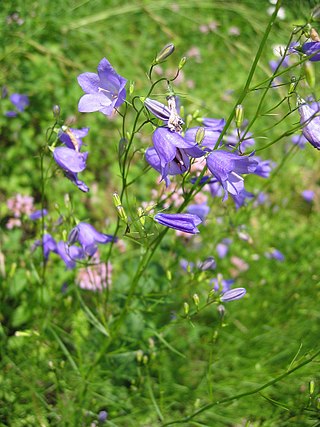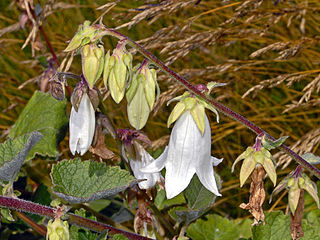
Campanula is the type genus of the Campanulaceae family of flowering plants. Campanula are commonly known as bellflowers and take both their common and scientific names from the bell-shaped flowers — campanula is Latin for "little bell".

Campanula rotundifolia, the harebell, Scottish bluebell, or bluebell of Scotland, is a species of flowering plant in the bellflower family Campanulaceae. This herbaceous perennial is found throughout the temperate regions of the northern hemisphere. In Scotland, it is often known simply as bluebell. It is the floral emblem of Sweden where it is known as small bluebell. It produces its violet-blue, bell-shaped flowers in late summer and autumn.

Campanula americana, the American bellflower, or tall bellflower, is a bellflower native to eastern North America. Tall bellflowers can be annual or biennial with a varying life-history with seeds germinating in the fall producing annual plants and spring-germinating seeds producing biennial plants. Long-tongued bees are the primary pollinators, including Megachile campanulae, but halictid bees, butterflies, and skippers may also act as pollinators. Tall Bellflowers do not generally self-pollinate. Some authorities, including the USDA PLANTS database, consider the name Campanulastrum americanum to be the accepted name for this species.

Campanula glomerata, known by the common names clustered bellflower or Dane's blood, is a species of flowering plant in the genus Campanula, belonging to the family Campanulaceae. It is the county flower of Rutland, England.

Campanula cervicaria, the bristly bellflower, is a species of flowering plant in the bellflower family Campanulaceae. The plant is roughly hairy and the flowers are about 1–2 centimetres (0.4–0.8 in) long, light blue and are grouped together.

Campanula rapunculoides, known by the common names creeping bellflower, rampion bellflower, rover bellflower, garden bluebell, creeping bluebell, purple bell, garden harebell, and creeping campanula, is a perennial herbaceous plant of the genus Campanula, belonging to the family Campanulaceae. Native to central and southern Europe and west Asia, in some parts of North America it is an extremely invasive species.

Campanula patula or spreading bellflower is a plant species of the genus Campanula. It can grow to more than half a meter high. This delicate bellflower bears lateral branches of pale blue or white flowers that are upright and funnel shaped. The leaves are narrow and pointed. Branches are often supported by the surrounding vegetation, so the plants can appear prostrate. The main difference between this and other bellflowers is that the petals in the bell are spread out and more pointed and this gives this species its common name.
Campanula angustiflora is a species of flowering plant in the bellflower family Campanulaceae. It is known by the common name Eastwood's bellflower. It is endemic to California, where it grows in the serpentine soils of the hills and mountains surrounding the San Francisco Bay Area. It is a flower of the chaparral plant community. This is a hairy annual herb producing a thin, branching stem up to 20 centimeters tall. The leaves are leathery in texture and oval in shape, measuring between 0.5 and 1 centimeter in length, with a few teeth along the edges. The bell-shaped flower is pale blue or white and just a few millimeters long. The fruit is a ribbed, spherical capsule.
Campanula californica is a species of flowering plant in the bellflower family Campanulaceae, known by the common names swamp bellflower and swamp harebell. It is endemic to California, where it grows along the coastline between Marin and Mendocino Counties. It is found mainly in wet areas such as bogs, marshes, and wet forest floors. This is a hairy rhizomatous perennial herb producing a thin, creeping stem 10 to 30 centimeters long. The thin, rippled leaves are oval in shape and between 1 and 2 centimeters long. The bell-shaped flower is pale blue with curving petals up to 1.5 centimeters long. The fruit is a ribbed, spherical capsule.

Campanula scabrella is a species of bellflower known by the common name rough bellflower. It is native to the mountains of the western United States, where it grows in talus and other rocky alpine habitat. This is a tough perennial herb growing in a clump from a woody rhizome and rarely exceeding 5 centimeters in height. The stiff leaves are linear to narrowly oval in shape and about 3 centimeters long, borne on winged petioles. The small funnel-shaped flower is just under a centimeter long and pale blue or lavender in color, arising from the leaf clump on an erect pedicel about a centimeter tall.

Campanula sharsmithiae is a rare species of bellflower known by the common names Mt. Hamilton bellflower and Sharsmith's harebell. It is endemic to California, where it is known from just a few occurrences in the higher mountain peaks just south of the San Francisco Bay Area, including Mt. Hamilton and Mount Boardman in the Diablo Range. It is a small, hairy annual herb producing an erect stem up to 25 centimeters tall. The fleshy, toothed leaves are a centimeter long or less. The flower is funnel- or bell-shaped and purple in color. The plant is named for late local botanist Helen Sharsmith.

Campanula shetleri is a rare species of bellflower known by the common name Castle Crags bellflower. The plant is named for Castle Crags, a mountain formation in its limited native range, within the Shasta-Trinity National Forest.

Campanula wilkinsiana is a rare species of bellflower known by the common name Wilkins' bellflower.

Campanula portenschlagiana, the wall bellflower, is a species of flowering plant in the family Campanulaceae, native to the Dalmatian Mountains in Croatia. It is a vigorous, low-growing, mound-forming evergreen perennial with deep purple flowers in summer. Other common names include Dalmatian bellflower, Adria bellflower and Campanula muralis.

Favratia zoysii, known commonly as Zois' bellflower, Zoysi's harebell, or crimped bellflower, is the sole member of the genus Favratia, closely related to Campanula (bellflowers).

Campanula cochleariifolia, common name earleaf bellflower or fairy's-thimble, is a species of flowering plant in the family Campanulaceae, native to the Pyrenees, Alps, French Massif Central, and Carpathian Mountains of Central Europe. It is a rhizomatous herbaceous perennial growing to 10 cm (4 in). Clumps of bright green leaves produce nodding pale blue bell flowers on wiry stalks. It is often found growing on limestone.

Campanula punctata, the spotted bellflower, is a species of flowering plant in the bellflower family Campanulaceae. This ornamental herbaceous perennial is native to Japan, Korea, China and Siberia, and is widely cultivated for its attractive bell-shaped flowers.

Campanula piperi is a species of flowering plant in the bellflower family, Campanulaceae. It is native to the Olympic Mountains on the Olympic Peninsula in the U.S. state of Washington. It has also been noted on Vancouver Island, British Columbia.

Campanula lanata, the woolly bellflower, is a biennial herb belonging to the family Campanulaceae.

Campanula petiolata, is a wild flower that is called western harebell when it is distinguished from Campanula rotundifolia or simply harebell when it is considered the same species. It is a species of flowering plant in the bellflower family Campanulaceae. This herbaceous perennial is found through much of the temperate areas of North America. It produces its violet-blue, bell-shaped flowers in late summer and autumn. It is closely related to Campanula rotundifolia and is considered either a subspecies or the same species by many botanists.


















